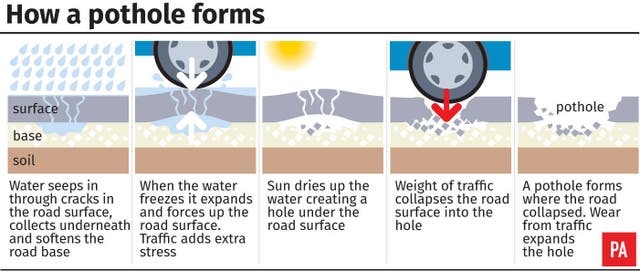
The fastest councils in Britain aim to fill severe potholes within minutes – but others take more than a day, new figures show.
Analysis by motoring research charity the RAC Foundation found that Cumbria, Flinstshire and South Lanarkshire try to act “immediately” to repair road defects which pose the greatest safety risk to drivers and riders.

Harrow Council has a target repair time of half an hour, while a further 16 councils aim to patch things up within an hour.
The most common response time is two hours, with 79 local authorities looking to patch up their roads within this period.
Coventry City Council has the longest target time for severe pothole repairs, aiming to respond within five days.
Response times are influenced by how many miles of road a council has to manage and the size of the council area.
The figures are based on data provided by 190 of the 207 local highway authorities in Britain.
RAC Foundation director Steve Gooding said: “It is understandable that large rural authorities set themselves longer response times, simply as a result of having to travel further to effect repairs, but motorists might still be surprised to see such a wide variation across the country.
“Those particularly vulnerable to potholes – cyclists and motorcyclists – might ask whether the speed of pothole investigation should be based solely on the risk to users.”
– These are the councils with the quickest target response times for serious potholes:
Immediately: Flintshire, Cumbria and South Lanarkshire
30 minutes: Harrow
One hour: Slough, Walsall, Sheffield, Rochdale, Bracknell Forest, Hartlepool, Warwickshire, Swindon, Worcestershire, Derby, Ealing, Bexley, Birmingham, Stoke on Trent, Wirral and Isle of Anglesey.
– These are the councils with the slowest response times to serious potholes:
Five days: Coventry
72 hours: Leicestershire
48 hours: Cornwall and Isles of Scilly
36 hours: Bournemouth
Further analysis by the RAC Foundation found that local highway authorities are increasingly adopting a risk-based approach to fixing road defects.
This means the volume of traffic and mix of road users is taken into account when deciding how quickly to act, as well as the size of a pothole.
Almost all authorities set minimum sizes for potholes before they will take action.
These vary from between 20-30mm deep at 37 councils to at least 50mm at 26 others.
One in five local roads in England and Wales is in a poor condition, and the frequency of road resurfacing has declined, a report by the Asphalt Industry Alliance warned.
Damaged shock absorbers, broken suspension springs and distorted wheels are among the most common vehicle problems caused by potholes.
The AA has called for learner drivers to have to prove they can spot potholes to pass the driving test.
Martin Tett, the Local Government Association’s transport spokesman, said: “Keeping roads safe for all users is one of the most important jobs councils do and is reflected in the fact that local authorities are fixing a pothole every 21 seconds, with priority given to repairing potholes that pose the greatest risk based on their size and location, as recognised in this report.”
He added that councils need “consistent and fairer government investment in local road maintenance”.

Enjoy the convenience of having The Sunday Post delivered as a digital ePaper straight to your smartphone, tablet or computer.
Subscribe for only £5.49 a month and enjoy all the benefits of the printed paper as a digital replica.
Subscribe